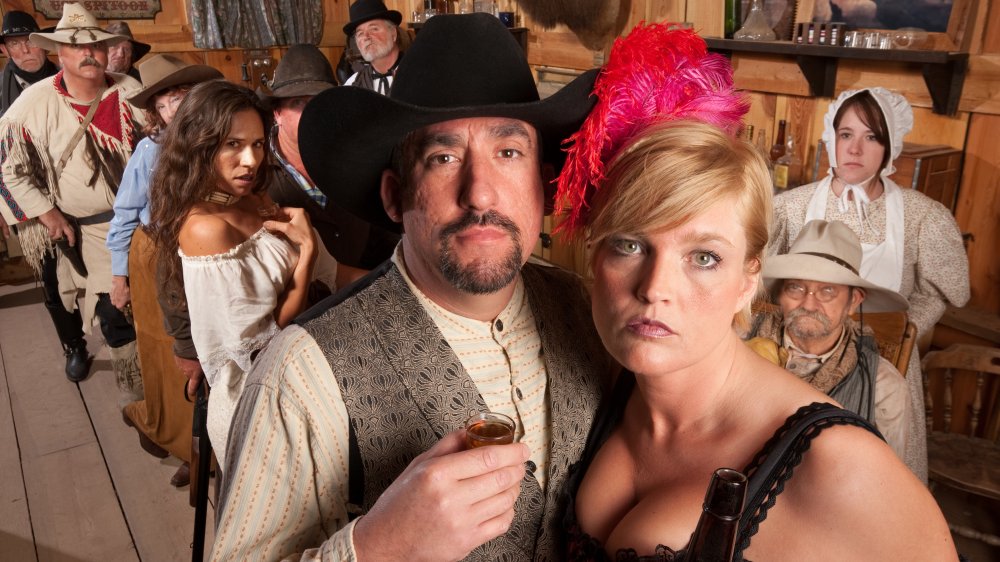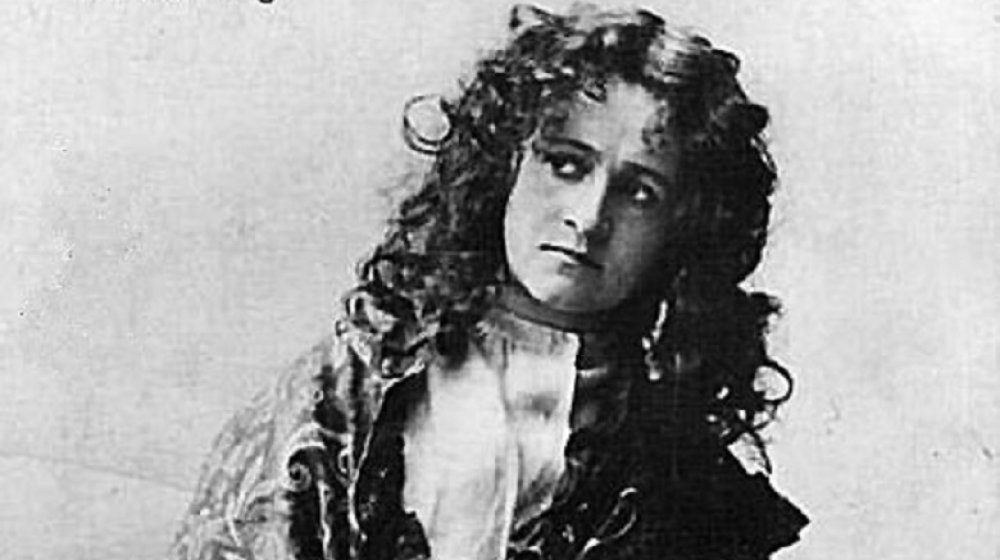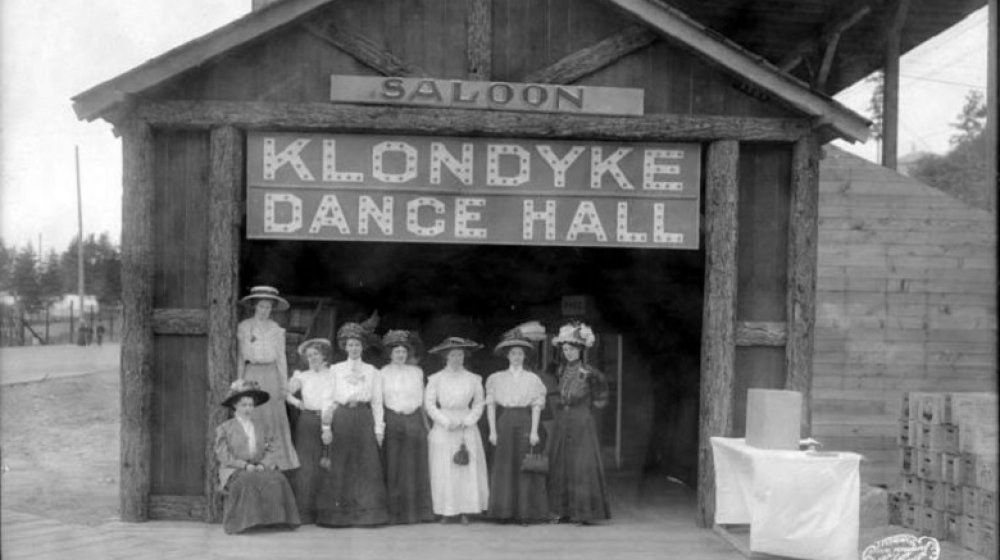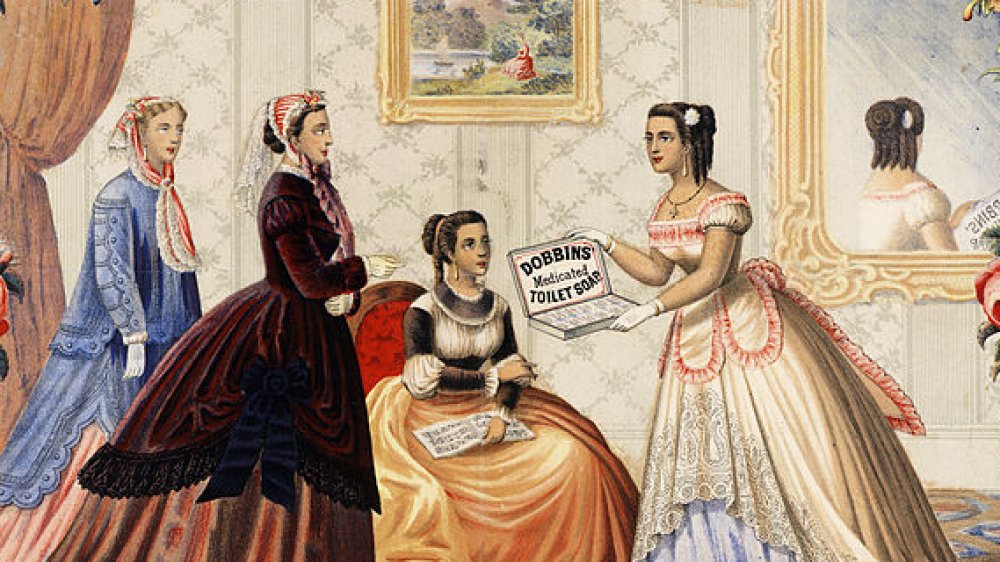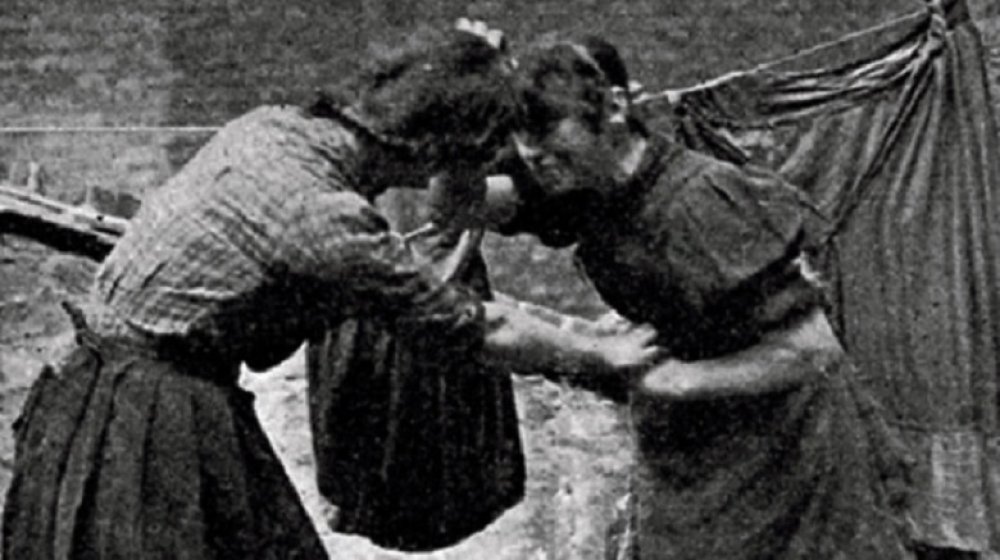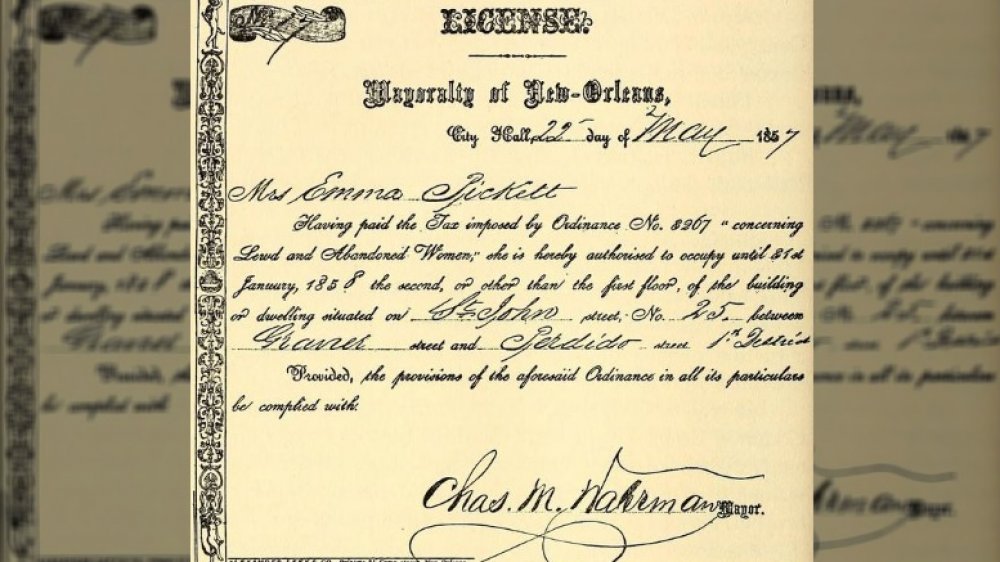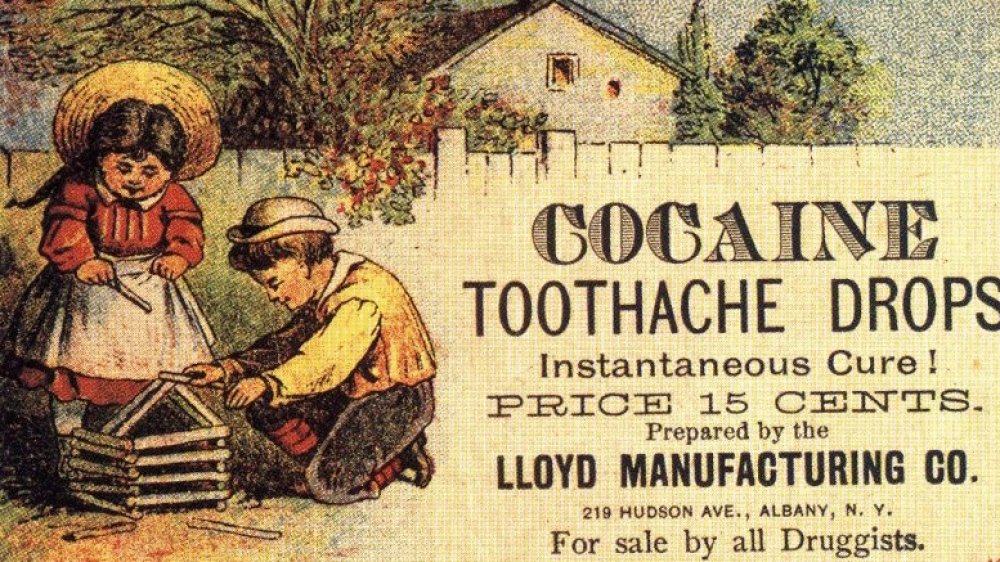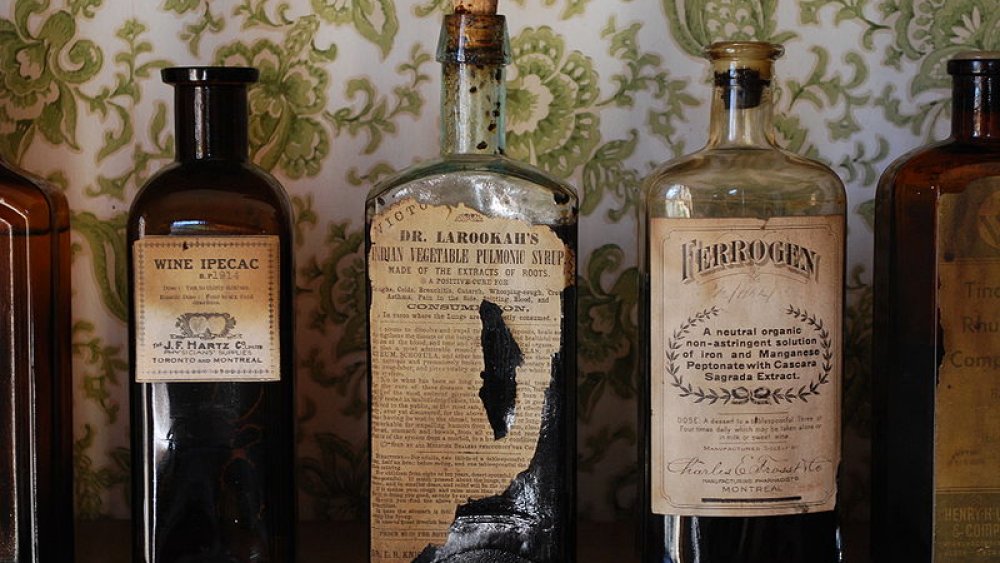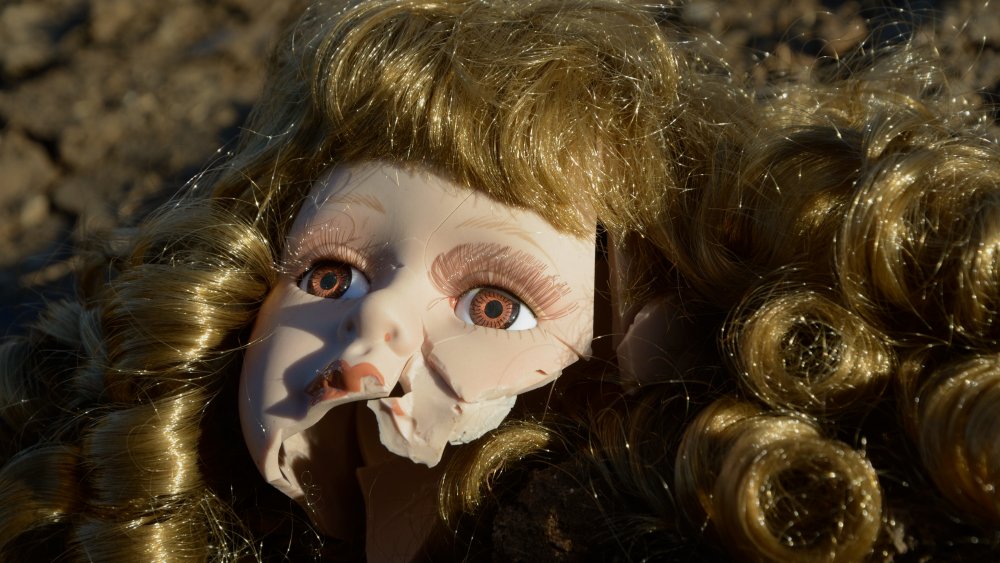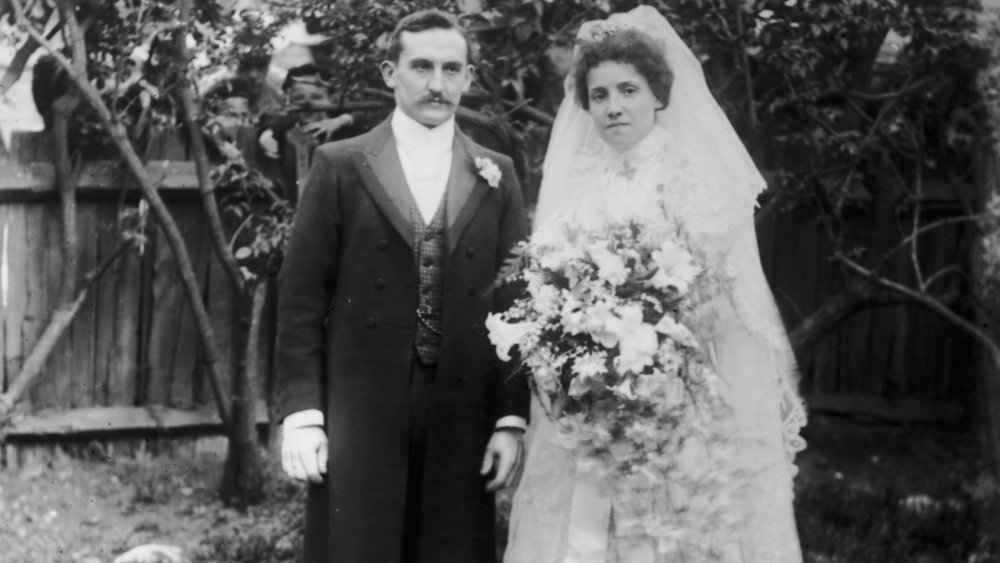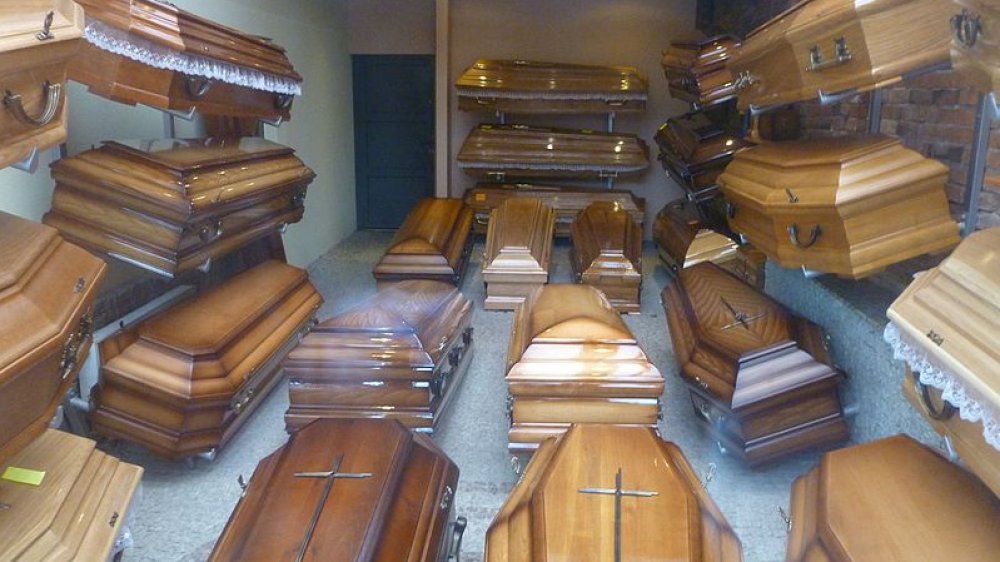What Life Was Like For Saloon Girls In The Wild West
Picture just about any western film. The scene is a classic old-time saloon. The usual assortment of cowboys are clustered at various tables playing poker, while a surly looking bartender wipes glasses behind the bar. A piano is sure to be present too, played by a man wearing a white shirt with garters on the sleeves. Down the stairs sweeps a typical "soiled dove," a lady with a painted face, hair swept up into a bun, wearing an exquisite gown with a low-cut bodice and lacy gloves. She is the most genteel and colorful character in the place, standing by the bar, fan in hand, waiting for the inevitable fight to break out. Yes, Hollywood has a bad habit of typecasting "saloon girls" as pretty little things whose job it is to stand around waiting for the right man to rescue them. Why is this?
In his thesis, "Reel or Reality? The Portrayal of Prostitution in Major Motion Pictures," Raleigh Blasdell rightfully theorizes the details of the sordid business of charging for intimacy remains largely hidden from the public. Rather than delving into the actual histories of these women, movie makers have preferred to portray "an inaccurate and often romanticized image of prostitutes in both the mass media and public imagination." That includes so-called "saloon girls," which have been construed to mean any woman who mingled with, danced with, or sold affection to men, according to Delancy Place. And, Hollywood saloon girls versus the real deal are quite different.
Why did women choose such a sordid profession?
Women stepped into the seedy side of life for a number of reasons. In the book The Lost Sisterhood: Prostitution in America, 1900-1918, author Ruth Rosen cites cases where some working girls were orphaned as children or came from broken homes. Others were widowed with no other way to earn a living. Writer Emma R. Marek found Laura Evens of Salida, Colorado, admitted to entering the profession simply because she "loved to sing and dance and get drunk and have a good time." Money was a motivating factor as well: Marek notes the few respectable jobs available to women offered low wages on which women, especially single ladies, could barely survive.
In addition, women made less money than men on every level. Alice: Memoirs of a Barbary Coast Prostitute notes as late as 1917, when the city of San Francisco attempted to eradicate the flesh trade, madam Reggie Gamble publicly attacked city officials, telling them if they wanted women to cease working in the oldest profession, the men "better give up something of their dividends and pay the girls' wages so they can live ... they will always be coming into it as long as conditions, wages, and education are as they are. You don't do us any good by attacking us. Why don't you attack those conditions?" Most saloon girls and working girls had no choice but to toil in less than ideal conditions to make their way in life.
The world of a working girl
The "office" of a working girl could range from the saloon or dance hall, to a "crib," to a fancy parlor house. Montana's first newspaper publisher, Thomas J. Dimsdale, described a typical "hurdy-gurdy" house as a "large room, furnished with a bar at one end ... and divided, at the end of this bar, by a railing running from side to side ... beyond the barrier sit the dancing women, called 'hurdy-gurdies.'" Dances cost $1.00 in gold apiece. Some women offered sex on the side, often operating out of small one or two-room apartments called cribs. Writer Hadley Meares described the cribs of Los Angeles as "squalid," often consisting "of nothing more than a makeshift bed and wash basin."
Lucky was the working girl who landed a job in an actual brothel or a parlor house, which Legends of America verifies were "elegantly furnished" and offered only the best in liquor, cigars, and food, as well as card games and other entertainment in addition to physical affection. These places employed beautiful and talented women, who were overseen by the madam of the house and made more than the common working girls. Madams tended to be astute business women. According to historian Clark Secrest, Denver madam Mattie Silks once explained, "I went into the sporting life for business reasons and for no other. It was a way for a woman in those days to make money and I made it. I considered myself then and do now—as a business woman."
The stink of the Old West
A picture may say a thousand words, but it cannot convey the acrid odors of the Old West. Back then, personal hygiene habits were definitely not what they are today. For one thing, bathing, brushing of teeth, washing of hair, and other healthy habits took place far less often. As writer Meg Mimms points out on her blog, Cowboy Kisses, shampoo wasn't even invented until the late 1800s. Women were relegated to using plain soap to wash their hair, and that only occurred once a month or so. Most good time girls kept a basin in their rooms, since cleanliness was important to both them and their customers. Deodorant and toothpaste were rare too, according to Elena Sandidge. Toothpaste wasn't available in a tube until 1892, and deodorant wasn't invented until 1888.
Most folks just had to make do with stinky pits and privates. Then there was makeup, which was basically taboo among proper women but used by both actresses, saloon girls, and prostitutes. Author Sylvia McDaniel verifies these women used small pots containing carminic acid and aluminum or calcium salts to color their cheeks and lips. They also used hair dye. Outside of their realm, however, shady ladies wore only enough cosmetics, like face powder, to make their skin appear as beautiful and natural as possible. But not until after 1900, according to The Old Farmer's Almanac, did manufactured eyebrow pencils, eye shadow, face powder, and lipstick become all the rage.
Competition within the workplace
Competition was tough among dance hall girls and working girls alike. Women were not beyond fighting, beating or even killing one another over money, possessions, or the attentions of men. As writer Carol Lee Bowers noted in an article about the profession in Laramie, Wyoming, "The fierce competition among prostitutes engendered hostility, suspicion, and jealousies which undermined the development of stable, rewarding friendships and bonds of unity." Unfortunately, women in the industry had few chances to makes friends outside of their realm; even friendships with others doing the same job "were usually tenuous."
Some of the more notorious squabbles between soiled doves included madam Etta Clark and "Big Alice" Abbott of El Paso, Texas. When one of Alice's girls, Bessie Colvin, left the madam to work for Etta, the two madams violently clashed and beat each other to a pulp. According to author Chris Enss, the fight ended when Etta shot at Alice, hitting her in what doctors identified as the "pubic arch." By chance or purpose, newspapers instead reported Alice had been shot in the "public arch." In Colorado, Leadville madams Mollie May and Sallie Purple were next door rivals who decided to battle it out with gunfire in what authors Vardis Fisher and Opal Laurel Holmes called "The Battle of the Painted Ladies." And Denver madam Mattie Silks once duked it out with fellow prostitute Katie Fulton before a large crowd along the South Platte River, according to writers Glenda Riley and Richard Etulain.
The cost of freedom
Saloon gals might have openly defied the law, but they were required to required to follow rules and protocols set by their employers. Money was the name of the game, and a girl who couldn't make it was shown the door. In the Klondike and many other places, dance hall girls were directed to get their customers to drink. For each dollar spent the girls were given an "ivory disk" according to Moondance, but metal tokens were sometimes used too. The girls dropped these items into their stockings throughout the evening (resulting in some mighty "lumpy" legs), cashing their stash in the next day. Legends of America verifies dances typically cost 75 cents to a dollar, and the girls generally split their take with the owner of the place.
In the case of prostitutes, women either split their earnings with the madam (who usually provided room and board), or paid her daily, weekly, or monthly rent. Some girls lived elsewhere and only rented their rooms by the night, while others lived in the brothel full time. No matter her job description, most saloon girls and working girls were required to pay regular fines, and license fees, to the city coffer. In St. Louis, Missouri, writer James Wunsch reports, the "social evil ordinance" required permits for all working girls. Also, much like other cities, prostitutes were only allowed to work with a clean bill of health issued by a city physician—whom the women also paid.
Saloon girls' issues with family, alcohol, and drugs
Because working girls had easy access to alcohol and drugs, it was not difficult to become addicted to either one. As author Jeremy Agnew points out, "The incidence of mental depression was high among prostitutes, so many of them turned to drugs and alcohol to relieve the loneliness and unhappiness of being far from family and friends." Christmas was especially hard, resulting in an increase in suicides. Curious Historian states most dance hall girls drank only colored water with their customers. Unfortunately, however, some pimps and madams encouraged addiction as a means of controlling their girls. Only high class madams kept strict rules about their girls' recreational use of drugs and alcohol.
Famous female alcoholics included roustabout Calamity Jane, whom writer James D. McLaird found was drunk much of the time as she ran around the Wild West. Jane made a living any way she could, from working as a dance hall girl to playing the part of prostitute with a number of men. She also cooked on occasion, but it was her drunken escapades that caught the attention of newspapers and later, historians. Then there was Celia Ann "Mattie" Blaylock, a working girl who became gunfighter Wyatt Earp's companion before he dumped her for actress (and possible prostitute) Josephine Marcus. According to Mark Nothaft at Arizona Central, Earp cast Mattie aside when she became addicted to laudanum for her migraines. Mattie went back to selling sex and later committed suicide.
If you or anyone you know is having suicidal thoughts, please call the National Suicide Prevention Lifeline at 1-800-273-TALK (8255).
Social disease ran rampant in the West
Venereal disease was widespread, and treatment of STD's was downright dangerous. As Christopher Knowlton explained in his book, Cattle Kingdom (via Delancey Place), prostitutes "faced the constant threat of disease — and not only sexually transmitted diseases such as syphilis, popularly known as 'the calamity' in light of the poor prospects for a cure, or gonorrhea, which was equally prevalent." STD treatment was limited as penicillin wasn't invented yet. Writer Keith Souter tells of using calomel, a powder of mercurous chloride, which could cause patients to "salivate, perspire, feel dry, want to vomit and purge their bowels," but these were symptoms of mercury poisoning. Likewise, gonorrhea also was treated with mercury, but also arsenic and other deadly elements, according to J.R. Thorpe at Bustle.
Men who contracted STD's could pass it on to their wives or working girls. In 1907, 19-year-old Anna Groves contracted venereal disease from one of her customers. When the man refused to do anything to help her, Anna fired a shot at him through the window of a Wyoming saloon. The bullet missed its mark but Anna was arrested anyway. In reporting the incident, Laramie's Semi-Weekly Boomerang noted Anna was in poor health, although she "pleaded guilty and expressed regrets that she was such a poor shot." Anna was sentenced to two years in the state penitentiary, but pardoned after five months when it became painfully apparent she was fatally ill.
Violence against working women in the West
Women may have sought vengeance against the men who wronged them, but violence against the fairer sex was more common. Sexual assault was rampant in the Old West, with few laws to protect women—especially working girls. Writer Nancy Williams is one of many who claim sexual assault was prevalent in the Old West. "Back then, women didn't report rape, because they knew their attackers would never be pursued," she wrote. History is unfortunately rife with reports of women being assaulted or killed. Historian Anne M. Butler tells of Mollie Scott, whose brute of a husband shot her to death one night and fled, leaving other prostitutes to dress the victim for her funeral.
Similarly, young scholar Emma R. Marek wrote about Madam "Belgian Jennie" Bauters of Jerome who moved to another town and was accosted by her ex-boyfriend in 1905. The man shot Jennie three times, then took time to reload his gun before he saw she "was not dead yet." The villain actually "moved her head so that he could get a better shot and then deliberately fired the pistol into her head." Writer Loretta Louis tells of one madam who exacted revenge when threatened. When a man with venereal disease was denied entry to Jennie Bright's brothel in Washington, he tried to hit her. The madam produced a revolver and shot the man neatly through the heart. Jennie left town until the murder blew over.
Pregnancy: The worst peril
One of the worst things a working girl could experience was an unwanted pregnancy, which put her out of work and made her business difficult. Boston University reported on one archaeological dig of a brothel which revealed syringes used to "inject mercury, arsenic, and vinegar into the body to induce abortions or treat diseases." The owner of the house, Mrs. Lake, later married a doctor who also prescribed medicines for treating sexually transmitted diseases and inducing abortions. But the women's biggest hurdle was the Comstock Act of 1873 which not only banned birth control items and information but also terminations. Thus women had to come up with their own homemade remedies to keep from getting pregnant.
The true number of infants produced by working girls in the Old West will never be known. Terminations were never reported because of the Comstock Act. Anne M. Butler wrote stillborns and fetuses were often quietly disposed of or buried without record. In February of 1877 Mary Kean, along with Mrs. and Mrs. Thomas Wicks, was charged in Laramie, Wyoming for failing to provide a proper burial for a fetus. The child was probably Mary's. Other women, such as Laura Evens of Colorado, were able to raise their children—sometimes out of the prostitution realm. In an interview with her great-grandsons, the men verified Laura's daughter Lucille "didn't talk about her mother," but "just described her mother as being a 'landlady.'"
Marriage: A viable option
The best a working girl could hope for was to marry and leave the profession for good. Emma R. Marek cites a respectable woman named Mary Mathews of Colorado who observed, "Sometimes a good citizen, wealthy and respectable, marries his wife from some of these corrupt houses, and he seldom ever regrets his choice. He builds her up to be respected and respectable. I have heard of several cases." Likewise, according to writers Vardis Fisher and Opal Laurel Holmes, Denver madam Mattie Silks told others, "My girls made good wives. They understood men and how to treat them and they were faithful to their husbands ... So I knew they made good wives."
Author Helen M. Lewis theorized men were willing to marry saloon girls and prostitutes largely due to the shortage of women in the early West. One of her sources cited the ratio of males to females as 10 to one, while another guessed there were "from three to 30 times as many unmarried men as unmarried women" in the West. Therefore any woman, described as "virgins, including aging spinsters, as well as widows, widows with children, divorcees, and prostitutes," were fair game. Still, some working girls were hesitant or even afraid to marry. In writing his memories of the gold rush, Tim Kinerk recalled "sweet-talking one of the dance hall girls, telling her about a nice farm in Indiana; but she said, 'No, Tim, you would not want me when you get that farm.'"
The end of the road
Working girls could succumb to any number of maladies, from complications of childbirth to violence to disease, or even suicide. And, as the Dodge City Times reminded its readers, according to writers Carol Leonard and Isador Willimann, "The frail humanity will respond to the demand of the depleted city exchequer, remembering that the wages of sin is death." But the cause of death was rarely old age. Suicides were common. Author Jeremy Agnew writes that during its boom years, 40 suicide attempts were reported in Virginia City, Nevada, 19 of which were successful. One of the most tragic suicides was that of Eleanora Dumont, aka Madam Moustache, a sometime madam and gambler who died outside of Bodie, California after losing all of her money.
At least some ladies, usually madams, were able to retire. In her thesis, "Angels for Sale: The History of Prostitution in Los Angeles, 1880-1940," AnneMarie Kooistra writes of madam Cora Phillips, the 24-carat Queen, of Bohemia" who ran several high class parlor houses. Cora was able to retire "with a fortune." The most famous madam of all in America is no doubt Sally Stanford. Writer Rae Alexandra reported Sally was not only a successful madam for decades in the San Francisco area, but that after she retired, she turned to politics. After five tries, Sally was victorious in being elected to the city council and later, mayor, of Sausalito. "We sinners never give up," she quipped.
If you or anyone you know is having suicidal thoughts, please call the National Suicide Prevention Lifeline at 1-800-273-TALK (8255).
